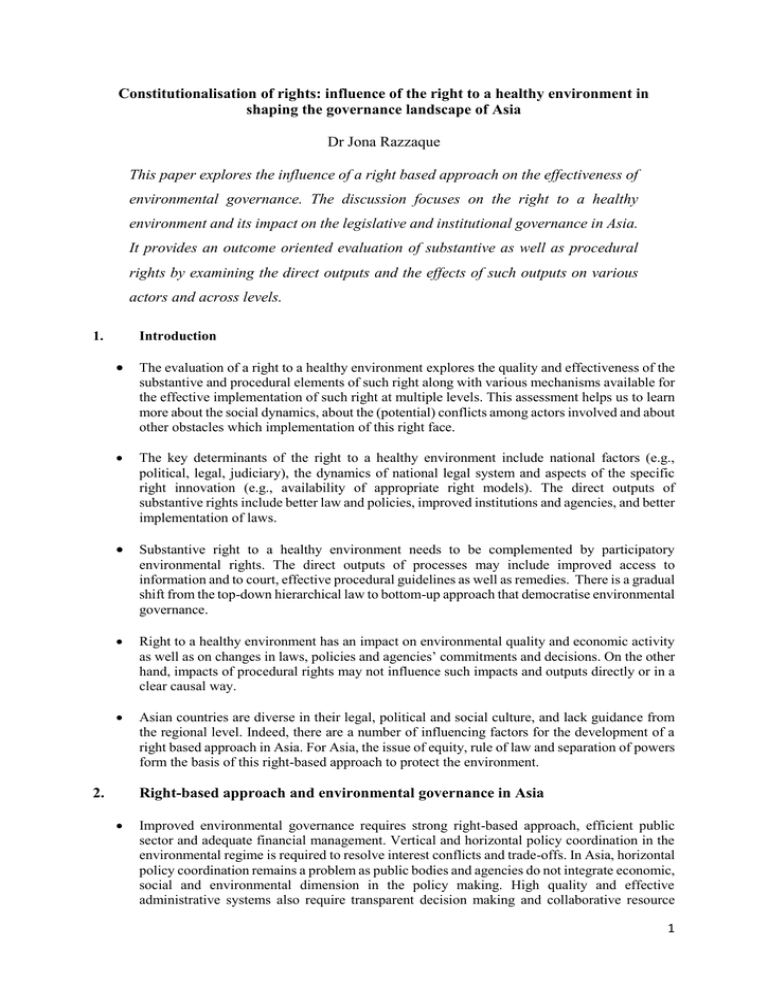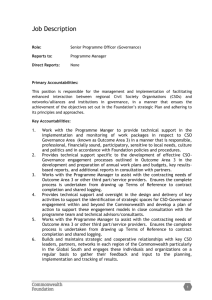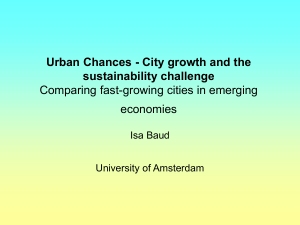Constitutionalisation of rights: influence of the right to a healthy... shaping the governance landscape of Asia
advertisement

Constitutionalisation of rights: influence of the right to a healthy environment in shaping the governance landscape of Asia Dr Jona Razzaque This paper explores the influence of a right based approach on the effectiveness of environmental governance. The discussion focuses on the right to a healthy environment and its impact on the legislative and institutional governance in Asia. It provides an outcome oriented evaluation of substantive as well as procedural rights by examining the direct outputs and the effects of such outputs on various actors and across levels. 1. Introduction The evaluation of a right to a healthy environment explores the quality and effectiveness of the substantive and procedural elements of such right along with various mechanisms available for the effective implementation of such right at multiple levels. This assessment helps us to learn more about the social dynamics, about the (potential) conflicts among actors involved and about other obstacles which implementation of this right face. The key determinants of the right to a healthy environment include national factors (e.g., political, legal, judiciary), the dynamics of national legal system and aspects of the specific right innovation (e.g., availability of appropriate right models). The direct outputs of substantive rights include better law and policies, improved institutions and agencies, and better implementation of laws. Substantive right to a healthy environment needs to be complemented by participatory environmental rights. The direct outputs of processes may include improved access to information and to court, effective procedural guidelines as well as remedies. There is a gradual shift from the top-down hierarchical law to bottom-up approach that democratise environmental governance. Right to a healthy environment has an impact on environmental quality and economic activity as well as on changes in laws, policies and agencies’ commitments and decisions. On the other hand, impacts of procedural rights may not influence such impacts and outputs directly or in a clear causal way. Asian countries are diverse in their legal, political and social culture, and lack guidance from the regional level. Indeed, there are a number of influencing factors for the development of a right based approach in Asia. For Asia, the issue of equity, rule of law and separation of powers form the basis of this right-based approach to protect the environment. 2. Right-based approach and environmental governance in Asia Improved environmental governance requires strong right-based approach, efficient public sector and adequate financial management. Vertical and horizontal policy coordination in the environmental regime is required to resolve interest conflicts and trade-offs. In Asia, horizontal policy coordination remains a problem as public bodies and agencies do not integrate economic, social and environmental dimension in the policy making. High quality and effective administrative systems also require transparent decision making and collaborative resource 1 management. If these elements are weak, it is likely that environmental concerns will be compromised within the governance architecture. The governance models – such as the regulatory, market based and participatory, cannot be compartmentalized and are not mutually exclusive. The participatory model of governance encourages the civil society to actively participate in the regulatory governance. The market instruments inform and strengthen regulatory frameworks. Several factors such political instability, decentralization, property right, integration of ecosystem concerns to markets, pricing of natural assets, accountability of state and non-state actors have an effect on how the environment is being governed. The changing of governance models requires institutional reforms as well. A move from regulatory to participatory governance requires change in legal provisions, and the administrative and decision making structure also need to be able to adopt these changes. Various approaches to governance in Asia highlight shared governance mechanisms that integrate public and private actors and aim better implementation of regulations. Participation of multiple and diverse actors in the governance processes and their changing roles (e.g. state as a decision maker to facilitator) raise accountability challenges, complexity of priority setting and the importance of horizontal/vertical linkages. Effectiveness of roles played by non-state actors largely depend on regulatory mechanisms, clearly defined roles (e.g. enforcement, monitoring, information gathering), the financial incentives structure and the decision making power they have. Thus, shared or participatory model of governance cannot simply be grafted on a regulatory system. The move from hierarchical regulation and the shift to a more collaborative regulatory approach is clearly a sign towards ‘new governance’ in Asia. There is a growing recognition of the limits of top-down regulatory approaches and more countries are adopting regulations that promote power sharing, participation and collaborative management. Most environmental regulations in Asia have mixed or hybrid form of regulations which are likely to work better than one pure form. Reference J. Razzaque, Environmental governance in Europe and Asia: A comparative study of institutional and legislative framework (Routledge, 2012) 3. Effectiveness of a substantive right to a healthy environment in Asia Constitutionalisation has an impact on political institutions, law-making and access to remedies. With its impact on due process, accountability, rule of law, separation of powers, and inclusiveness, constitutional guarantees such as the right to a healthy environment provide a framework to revisit the interactions between different constitutional elements, explore relationships between public and private actors, and facilitate the move from pure economic to sustainable globalisation. The discussion on contributions of the substantive right to a healthy environment will focus on the implicit and explicit nature of the right, types of right (e.g., constitutional right, community/individual right, right for future generations), direct outputs (e.g. law, regulations, agencies) and enforcement measures. In Asia, substantive right to a healthy environment includes right to life, livelihood, water, access to natural resources, etc. It is important to note the application of public trust doctrine in Asia. The balancing of competing interests is common in many of the cases brought before the national courts. One recent example is the growing of grains for biofuels in some Asian 2 countries that is said to be endangering the food security of millions of people. Whose interests will be prioritised in a conflict between right to food and right to property? One example is the large-scale water infrastructure project that displaced indigenous people from their land and adversely affected the natural resources where the Indian judiciary had to balance the development aspects, human rights and the environmental concerns. Another example is where mining activities undertaken by multinational companies were challenged in the national courts and the judiciary restricted the way resources were being extracted or utilised. Exposure to the law corresponds to how the community and public bodies respond to the right based approach. Differences in capacity affect response to law which can be proactive and reactive. For example, the environmental regulations may assign government agencies to take action in case of any regulatory breach. In this instance, the community needs to have access to other remedies in case the public agency fails to take any action. Proactive and cooperative regulatory option anticipates problems and helps claimants and affected communities/victims find solutions. Similarly, the judiciary may take proactive or reactive role. However, this judicial empowerment (or intrusion) may not always ensure long term legislative or institutional change. Reference J. Razzaque, ‘Right to a healthy environment in Human Rights Law’ in Prof M. Baderin and M. Ssenyonjo (eds.) International Human Rights Law: 60 Years after the UDHR (Ashgate, 2011), 115-135. J. Razzaque, ‘Linking Human Rights, Development and Environment: Experiences from Litigation in South Asia’ (2007) Fordham Environmental Law Review, vol. 18, No. 3, 587-608. J. Razzaque, Public Interest Environmental Litigation in India, Pakistan and Bangladesh (Kluwer: Netherlands, 2004) J. Razzaque, ‘Human Rights and the Environment: the national experience in South Asia and Africa.’ (2002), Presented at the OHCHR/UNEP Expert Meting on Human Rights and the Environment, available at: http://www2.ohchr.org/english/issues/environment/environ/bp4.htm 4. Asia Right to a healthy environment, participatory rights and procedural outputs in The meaning of public participation includes opportunity to participate in the decision-making process, ability to gather information and access to legal redress. While the final decision is important, the process through which the decision is achieved is also crucial. However, the division between the substantive and process rationale is not always very clear. A range of activities involving public participation has evolved over the years. The level of participation by affected communities has an impact on the sustainability of the decision. For example, a substantive right to ecosystem services usually requires procedural rights to be heard in decisions that might affect the substantive right. Several factors influence the development of participatory rights in Asia. External actors such as international financial institutions, donor agencies and UN agencies play an important role to develop the concept of participation, implement participatory environmental reforms and integrate these into the policies and regulations in Asia. In addition, the development of the participatory environmental rights is also influenced by the participation provisions in the multilateral environmental agreements – a large number of Asian countries are parties to these agreements. Integration of international standards into national laws has strengthened access rights. Moreover, pressure from the international civil society against various large development or infrastructure projects (e.g., Narmada dam in India; Arun III dam in Nepal) 3 prompted many bilateral and multilateral institutions to introduce environmental and social safeguards in the project funding. Also, NGOs in Asia play a very critical role to promote ‘people’s empowerment’ by supporting participation agenda at the law and policy making level. Lastly, the increasing use of participation in community-based natural resource management policy as evidenced in the forest management (e.g., Nepal, India) and coastal resource management (e.g., Philippines) influence the development of participatory rights. In Asia, various domestic avenues offer formal participatory provisions through, for example, Constitutional provisions, legislative frameworks, judicial decisions including public interest litigation. Important informal avenues involving protests, political pressure and mediation also exist at the national level. Many developing countries in Asia went through a phase of legal reforms for better environmental management during the 1970’s and 1980’s. Reforms in access to justice and access to information began slowly, if at all in some countries. The adoption of participatory framework for decisions affecting the environment initially met with modest success, as most countries lacked a strong domestic demand for participatory processes. In many Asian countries, participatory rights are established through Constitutional provisions. Some Constitutions accommodate provisions on right to information and public participation (e.g., Thailand, Indonesia, Philippines). A number of Asian countries (e.g. India, Japan, South Korea, Pakistan) passed access to information legislation. In some countries (e.g. Thailand) environmental protection laws provide specific provisions for environmental information complementing access to information laws. Effective participation also depends on the availability and quality of information. For example, in cases relating to dam projects (e.g., in India, Thailand, Malaysia, Philippines) information relating to loss of forest or wetlands or livelihood was not available to the local communities. National regulations also elaborate these rights and some countries have specific laws that give effect to participatory rights to resource management. These laws may include specific procedures providing guidelines on consultation and post-project monitoring and ensuring information and participation (e.g. plans for large infrastructure projects). Some countries have guaranteed citizens the right to seek judicial review when access to information or public participation is wrongfully denied. In addition, the national EIA legislation may include provisions on information and participation of communities in the decision making process (e.g., China, India, Pakistan). The effectiveness of bottom-up approach in environmental governance depends on the information given to the community and people on the proposed activity, active participation of local people in the decision-making and shared responsibilities in implementation. For example, community managed forest projects are better managed with equitable outcome when local communities are actively involved (e.g. India, Nepal, Philippines, Malaysia). In recent years, many Asian countries are recognising the importance of inclusive and new governance that provide greater scope of direct participation by and knowledge sharing among public bodies, communities, private actors and NGOs. A large number of NGOs in Asia are working towards better access to natural resources, assisting communities suffering from the direct impact of pollution (e.g., Philippines, Thailand), taking part in environmental monitoring (e.g. Bangladesh), and promoting environmental education. In addition, local governments play an important role in involving local communities in the preparation of policies aiming to achieve sustainable development (e.g., India, Bangladesh). Access to courts by communities and NGOs depends on the legal systems, democratic traditions and legal cultures of states. In Asia, public interest litigation (PIL) offers a procedural 4 mechanism that allows individuals and NGOs to vindicate a ‘public interest’, and it has been widely used to uphold environmental law (e.g., Malaysia, India, Sri Lanka, Bangladesh, Pakistan, Philippines). Indeed, the development of PIL in Asia is not homogenous and the growth depends a on the political and legal culture of a country (e.g. China, India). Criticisms regarding costs, legal aid and lengthy procedure aside, PIL in the developing world has become a forum for people to voice their concerns on environmental matters and reflects a communitarian approach. However, access to courts may not ensure procedural justice or a just substantive outcome. Reference J. Razzaque, ‘Participatory environmental governance: assessing the role of communities in Europe and Asia’ in Environmental governance in Europe and Asia: A comparative study of institutional and legislative framework (2012, Routledge) 57-90. J. Razzaque, ‘Information, public participation and access to justice in environmental matters’ in S. Alam et al (eds.) Handbook on International Environmental Law (2012, Routledge) 137-153. J. Razzaque, ‘Ecosystem Services and Human Well-being in a Globalized World: Assessing the Role of Law’ (2009) Human Rights Quarterly, vol. 31, 692-720. Co-author: Elena Blanco. J. Razzaque, ‘Participatory rights in natural resource management: role of communities in South Asia’ in J. Ebbesson and P. Okowa (eds.) Environmental Law and Justice in Context (2009, CUP) 117-138. 5. Concluding remarks There is an increasing focus on the ‘rights-based approach’ in Asia which argues for the rights of citizens to be engaged in the decisions and processes which affect their lives. In Asia, the participation agenda often manifested in calls for greater local community involvement in development planning and poverty alleviation projects, especially in the context of development aid schemes. However, effective and informed participation of stakeholders, regular monitoring and evaluation, deliberative tools, information gathering tools, planning tools are required to decide between various competing uses. No market based instrument can improve environmental management if the basic problem of rights allocation is not addressed by the national governments. Many deficiencies with public participation can be traced to flaws in the enabling legal and institutional frameworks. Even if there is an effective judicial system, in many instances it is not cost effective, standing rules are often restricted and legal assistance is rarely available for environmental cases. While these participatory reforms have improved the quality of many environmental decisions, they have hardly engendered a major paradigm shift to ecologically sustainable development. 5




